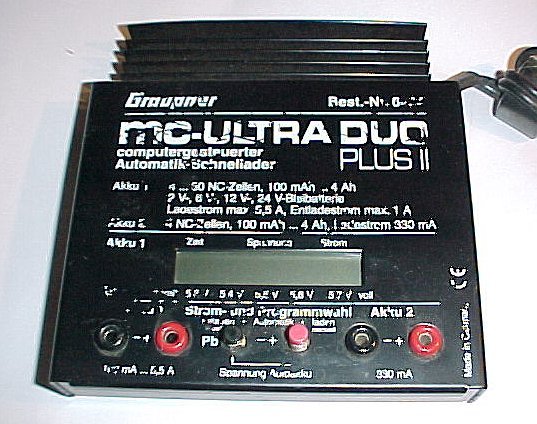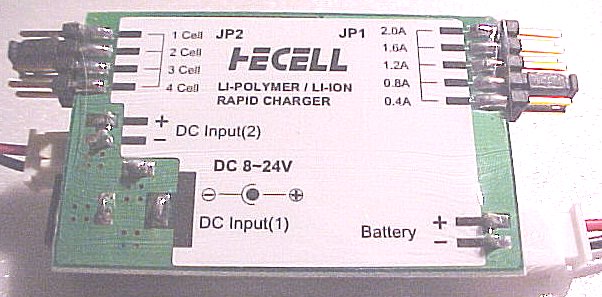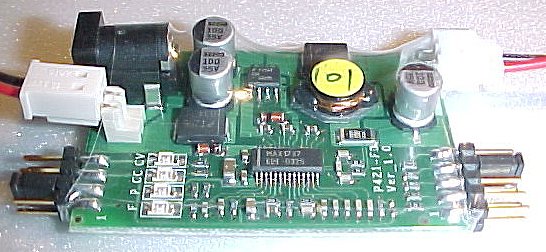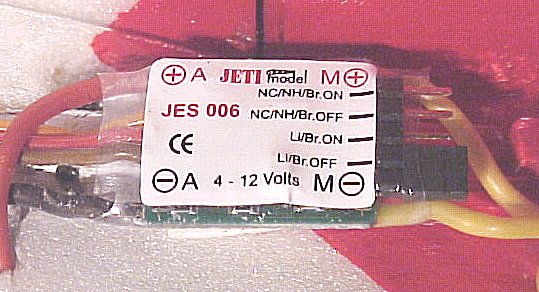
It must be stressed that the use that we are making of all batteries used in electric flight applications goes far beyond anything that they were designed for. Some of them stand up to this extremely well, but life will always be short. As a rule of thumb, 100 cycles is about all you can expect before there is an obvious drop in performance.
A couple of years back, word went out that nicads were to be outlawed under EEC regulations and this led to no more work on nicads. It now seems that this was a 'false alarm' and new types of nicad are now becoming available. Advancements in motors and model design have also meant that smaller cells can give the sort of power that is needed, it now being possible to get good performance from models powered by 150 mAh cells of 2/3 AAA size.
The advent of cells with different constructions and better energy densities means that nicads are no longer the battery of choice for those after real performance. However, in terms of availability, both of cells and chargers, plus many years of experience in development and use, they still have much to offer.
The actual rate of charge that they will tolerate can be incredibly high. There used to be a saying in the R/C Car world to the effect that, "The faster you put it in, the faster you can take it out". It is possible today to buy small electric F/F models which are charged by putting two 'pencell' 1.5 volt batteries directly across a single 50 mAh cell with no current limiter. Performance is amazing, but the instructions do advise a maximum charge of 45 - 60 seconds! It is possible to control the climb performance by controlling the charge rate, but I have not seen any published work on this.
In the early days it was common to charge Sub-C cells at 2 - 3 amps and use a clockwork timer to limit the charge. This system still works quite well, but needs experience to get the best from the cells and the possibility of a mistake is high. It is much more convenient (and probably safer) to use some form of automatic charger, which works by detecting when the cells are almost fully charged. These are known as 'Delta Peak' chargers.
One of the best known disadvantages of nicads is the so-called 'memory' effect. This really means that a cell which is regularly called upon to give only half of its available performance will eventually be incapable of giving more than that. In electric flight applications, it is unlikely to be of importance, since we habitually fully charge them and then fully discharge them. If you consult a manufacturers user manual you will find that this is the worst thing you can do to them.
Some people advise cycling batteries to remove memory effect. All you are doing here is wasting cycles. This is also said to recover 'lost' performance. Let's just say here that the manufacturers don't agree. My advice: don't cycle.
Occasionally, say once per year, it is a good idea to give a battery pack a slow charge (C/10) to even up the charge state of the cells. You can then fly them in the usual manner. Normally, you will get less power but a longer flight. If you must discharge batteries, the easiest and simplest way is to fly them. You could simply run them down in the model, but this is not a good idea because you will use more current and this can cause overheating. Anyway, why waste a flight?
I normally fly until the BEC (battery eliminator circuit) in the ESC (electronic speed controller) cuts out. This means that you are discharging the battery to the same point every time and can build up a database of charging info.
My original 'Twicell' packs are still in use and have around 200 cycles on them. On at least three occasions they seemed to have become tired and I stopped using them. After a rest of 2 to 3 months they seem to rejuvenate themselves and give good flights again. There is a slow but steady loss of performance and they now give maybe 75% of their original flight time.
There are now several types of cheap NiMH batteries on the market, both 'AA' and 'AAA' size. Maplin Electronics have had various special offers on cells. The first of these were made by Kodak and were 700 mAh capacity. I made up one 8 cell pack as an experiment. At first I wished I had bought more but after about 40 cycles they dropped right off in performance and became totally useless. Almost a year later, I tried them again and found to my surprise that they once again gave good flights. I can't explain this effect, but it seems to be repeatable.
Maplin soon dropped the Kodak cells but introduced cells under the Vanson name. These were initially 1800 mAh AA size and 750 mAh AAA size. The 750 size are excellent and don't seem to suffer from either the tiring effect or the aging effect. There have been various offers in the stores and they are even cheaper if bought from the Maplin website - around 75p per cell. I note that the latest versions of these cells have been uprated to 2400 and 800 mAh respectively - no doubt the price will rise accordingly.
At an early point in my flying of lightweight, mainly indoor, models, I obtained a 6 cell pack of 300 mAh 2/3 AAA size cells from Overlander. The first one simply didn't work and was returned for replacement. This took something over a month. At around 1.5 ounces, this gave excellent performance and I could get something like 14 minutes of flying on my 'Tiny'. Later, when I wanted more power, I obtained a pair of 7 cell packs. These gave poor performance. I also obtained a third pack, from another source although still of Overlander origin. This was replaced twice by the supplier and all were very poor. After a total experience of 7 packs of these cells, only one of which worked, albeit superbly, I don't recommend them. My alternative supplier was quite upset to discover that Overlander were selling them at less than half the price that they were charging him.
Once again, a lot of people advised cycling and slow charging to restore performance. I always found that any change in the charge characteristics produced poor flights (or no flight) and that it took 5 or 6 normal charge/flight cycles before the performance returned to normal. We are told that NiMH batteries don't have any 'memory' effects, but this sounds remarkably like memory to me.
One thing that most people agree on is that you must give NiMH cells at least one slow (C/10) charge before fast charging them ('fast' charging meaning at 1C). You can fly the cells after this charge and should get a reasonable flight. I normally give cells 3 slow charges before fast charging them. I have ruined cells by fast charging them from new without the slow charge. All the manufacturers advice suggests that you should not exceed the 1C charge, but many modellers do charge at higher rates - you're on your own here.
A major breakthrough occured when I built a collective pitch Hornet for a friend. This had very poor performance and flew for only about 3 minutes on my well-used packs and a new pack. I was surprised when the friend reported that he was getting good performance and 7 minute flights, "Exactly as you set it up." When I asked what he was doing differently, I was invited to borrow his charger.
This was a Graupner 'Ultra-Duo Plus II' (price in the UK around £170 - he is the importer). I could go on and on about this charger (I may do so on a separate page). For example, I found that if I charged a battery pack on the Jeti charger and let it cool, I would get a flight of less than a minute from the heli. If I then put the pack on charge with the Graupner charger, it would cut out after only about 3 minutes. I could then get an 8 minute flight! What's more, the cells are cool after charging and you can leave them several hours and still get good flights. When attending local indoor evening R/C meetings, I now normally charge the cells in the early afternoon and don't bother to take a charger with me.
It's a complex charger and has various automatic charging programs for Lead-Acid and Nickel Cadmium batteries, including cycling. These can be fully automatic or you can set the charge and discharge rates. For Nickel Metal Hydride batteries, the advice is to set the charge sensitivity to 'Sensitive' and set the current manually. I charge the 750 mAh Vanson cells at 0.8 amps. In case you are wondering, I managed to barter with the friend and obtained a second-hand unit - hence the scratches.

The plus side is that they have roughly twice the energy density of NiMH (4 times that of Nicads) and do not suffer from any kind of memory effect - I reserve judgement on that one until I have more experience. They also have a nominal cell voltage of a little over 3.6 volts (3 times Nicads/NiMH).
Having read the dire warnings about the use of Lithium-Ion batteries, I decided that I didn't need them. After all, I was getting reasonable results from NiMH batteries with the Graupner charger. It eventually became clear that I was missing something and I decided to buy one size of Lithium-Ion battery (2 cell 700 mAh) and a dedicated charger (less chance of mistakes that way, or so I thought). In the event, I was persuaded to buy a charger with more than one output. This was the HE Cell charger sold by Hillcott Electronics, among others. This can select 1 - 4 cells and four different charge rates, by means of jumpers. A minor niggle is that the cell tappings, in ascending order, go the opposite way to the charge tappings. Be careful!


If you want to build your own charger, you can find several circuits on David Theunissen's Fly Electric site.
Cutting a long story short, I managed to short the battery by accident. It became hot and started to swell up and was dispatched to the garden. I recovered it next day, cut the plug off and threw it away (the battery, not the plug). I now had a versatile charger and no batteries!
Having replaced the battery with an identical unit (at least, I now knew what not to do). It appeared to have similar performance to a 7 cell AAA NiMH battery - at less than half the weight! This was a difference that clearly couldn't be ignored. I was aware that Lithium-Polymer batteries were lighter and capable of more performance, but decided to acquire more experience with what I had before proceeding further.
At this point we have to consider all of the various warnings about not discharging below whatever volts per cell ('whatever' because every figure I've seen is different). I was told by various people that there was a very noticable drop in performance well before the cells were discharged too far. From observation I agree. Since I couldn't afford to replace my ESC at this point, I hedged my bets by designing a warning light. However, see later.
This charger charges at constant current initially and the goes to constant voltage to 'top-up' the cells. It appears to work as advertised and I have had no problems so far (clutches piece of wood).
Performance was very similar to the Li-Ion, the point being that I now had no real reason not to try a whole range of batteries, although I must admit to being reluctant to depart from one capacity (700 mAh) to reduce the possibility of error. This situation obviously couldn't last and we shall see whether my aging grey matter can cope.
I had by now become aware that Kokam batteries were reckoned to be the way to go and enquired where they could be obtained. The answer was Graham Stabler (Indoor Flyer). Graham operates a very civilised arrangement whereby he sends you the items you require and then you send him a cheque. Long may he prosper.
Thus, I obtained 2 cell packs of 340 and 640 mAh. The general advice for the current breed of Li-Ion and Li-Poly is that you can discharge them at 5C continuously, or 7C for short periods. The 340 Kokam is a little special because it can apparently be discharged at up to 20C.
On that basis, it would appear that the 340 size is the way to go, but the 640 has nearly twice the capacity, but is only 50% heavier. I can say that I have flown a twin motor GWS IPSD unit with both and the only difference seems to be in flight time.
I was getting around 14 minutes from my Tiny with the 340 mAh cells and a GWS IPS unit, with a noticable drop in power over the last minute or so. Then, on one flight, the motor cut out in the air. Was this disaster? After landing, the motor would run for a short time and then cut out again. I charged the cells and tried them and they seemed OK so I deliberately did the same thing on the next flight without apparent ill effects.
It is difficult to establish exactly what voltage an ESC is designed to cut out. I'm going to do some bench tests in the hope of finding out. I have now run one set of cells (now known as 'sacrificial lambs') down to cut off with both a GWS 2 amp ESC and a Jeti 5 amp. Logic says that the cut off voltage should be around 5 volts, or more, in order to continue to safely drive the radio equipment and that is above most figures given for a safe terminal voltage for the Li-Poly cells.
The problem is that the 'on load' voltage depends on the load and, with a high load, could be low enough to damage the cells. Actually, it appears that the cells contain circuitry which acts like a fuse and opens the circuit at low voltage to prevent any heating. I know from experience that this doesn't work if you short them?
Jeti are now producing an uprated version of their 5 amp ESC (the 'JES 050') called the 'JES 006' (info here). This incorporates a set of jumper connections which allow you to select Nicad/NiMH or Lithium and brake or no brake. In the UK, the 006 actually costs less than the 050. By curious coincidence, very few traders seem to know about the new unit.

There is, potentially, an approaching problem here. With the increasingly large variation in cell capacities, I am going to need a more versatile charger or maybe need to make some specialised chargers for specific cells. Some of my interests may find the newer very small Li-Poly cells useful. This goes right back to my original misgivings.
I am currently using a pack of 2 x 1200 mAh Kokam cells to fly a Hornet helicopter. This has a Speed 300 motor with Jeti 05 ESC and draws around 5 amps. Using one of my warning lights as a back-up, the heli is still flying when the light comes on and the battery is just barely warm. So far, I've stopped flying at this point and have not run to the cut-off point, mainly because I'm surprised that the heli is still flying!
I've more or less committed myself to using Li-Poly cells for all future projects. All my older models will continue to use NiMH for the majority of flights. I've started to use some of the new, smaller cells for certain projects and build dedicated chargers for each type using the charger circuit on the Fly Electric site based on the L200 voltage regulator IC. These seem to work very well. My next move is to try a 3 cell pack. I still have misgivings about the possibility of error but progress is inevitable...
The common use of 340 mAh Li-Poly cells for brushless motors on shock flyer type models seems to have no real ill-effects on the batteries, despite low flight times. I'm told that the newer 360 mAh types are much better and can now confirm that they seem to hold up better at high currents. There is no doubt that this particular cell size is a cut above average and 640 mAh cells produce no real improvement beyond a little more power at the start of the flight.
My experience to date is that the normally advised current limit of 5C for continuous use and 7C for short bursts is about right but the 7C can be exceeded at the expense of drastically reduced capacity. Some cells can exceed this, both the 340 and 145 mAh sizes can go to 20C. All of this is in the process of becoming history as the current rate of development means it will be outdated by the time anyone reads this.
Only a couple of years ago it was considered impractical to fly a Hornet helicopter on any kind of lithium battery without changing to a brushless motor. There is now a choice of cells which can be used to fly the standard machine. The above mentioned 1200 pack gives in excess of 10 minutes flying time and the flying weight is reduced by some 1.5 ounces.
Very little seems to have been written on the subject, but Lithium-Polymer cells display this same effect. On my helicopters fitted with a warning light, there will be a drop in power, followed by the warning light coming on. After a rest of a minute, the same thing can be repeated with a flight of two minutes or so and then again with a shorter flight. This is probably because the cells are being pushed beyond their most efficient loading. There is a small RTF toy helicopter sold under various names ('Bladerunner' being one) which refers to this effect in the instructions. If you proceed with caution it takes quite a while to become aware of this fact, as may be noted above. This may be no bad thing!
The point here is that this effect seems to be almost completely absent on Ni-cads. When they are exhausted, that seems to be the end of things until they are recharged. Healthy Ni-cads run down very suddenly. Less healthy ones run down very gradually and it is difficult to establish just when they are fully discharged. The latest types seem to be very poor in this respect and I, for one, regret the passing of the 1700 SCR cell which seemed to be just about the ultimate in Ni-cad technology. I have a set of 2400 'N' type cells which have never been good and recently acquired a set under the name Tornado quoted as '1920+' which have never accepted more than 1750 mAh, have poor power and give low flight times.
| 6 cell 700 mAh AAA MiMH battery (Vanson) | nominally 7.2 volts | 77g. |
| 7 cell 700 mAh AAA NiMH battery (Vanson) | nominally 8.4 volts | 89g. |
| 2 cell 700 mAh Lithium-Ion battery (Enjoy Model) | nominally 7.3 volts | 42 g. |
| 2 cell 700 mAh Lithium-Poly battery (Falcon Models) | nominally 7.3 volts | 35 g. |
| 2 cell 640 mAh Lithium-Poly battery (Kokam) | nominally 7.3 volts | 30 g. |
| 2 cell 340 mAh Lithium-poly battery (Kokam) | nominally 7.3 volts | 22 g. |
| 2 cell 250 mAh Lithium-poly battery (E-Tec) | nominally 7.3 volts | 13 g. |
All of the voltages are higher in the fully charged state and the Li-Ion/Li-Poly are closer to the 7 cell NiMH than the 6.
